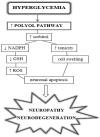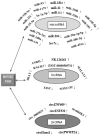Relationship between Biochemical Pathways and Non-Coding RNAs Involved in the Progression of Diabetic Retinopathy
- PMID: 38202299
- PMCID: PMC10779474
- DOI: 10.3390/jcm13010292
Relationship between Biochemical Pathways and Non-Coding RNAs Involved in the Progression of Diabetic Retinopathy
Abstract
Diabetic retinopathy (DR) is a progressive blinding disease, which affects the vision and quality of life of patients, and it severely impacts the society. This complication, caused by abnormal glucose metabolism, leads to structural, functional, molecular, and biochemical abnormalities in the retina. Oxidative stress and inflammation also play pivotal roles in the pathogenic process of DR, leading to mitochondrial damage and a decrease in mitochondrial function. DR causes retinal degeneration in glial and neural cells, while the disappearance of pericytes in retinal blood vessels leads to alterations in vascular regulation and stability. Clinical changes include dilatation and blood flow changes in response to the decrease in retinal perfusion in retinal blood vessels, leading to vascular leakage, neovascularization, and neurodegeneration. The loss of vascular cells in the retina results in capillary occlusion and ischemia. Thus, DR is a highly complex disease with various biological factors, which contribute to its pathogenesis. The interplay between biochemical pathways and non-coding RNAs (ncRNAs) is essential for understanding the development and progression of DR. Abnormal expression of ncRNAs has been confirmed to promote the development of DR, suggesting that ncRNAs such as miRNAs, lncRNAs, and circRNAs have potential as diagnostic biomarkers and theranostic targets in DR. This review provides an overview of the interactions between abnormal biochemical pathways and dysregulated expression of ncRNAs under the influence of hyperglycemic environment in DR.
Keywords: biochemical pathways; biomarkers; diabetic retinopathy; ncRNAs; oxidative stress.
Conflict of interest statement
The authors declare no conflicts of interest.
Figures




Similar articles
-
Mechanistic and therapeutic perspectives of non-coding RNA-modulated apoptotic signaling in diabetic retinopathy.Cell Biol Toxicol. 2024 Jul 6;40(1):53. doi: 10.1007/s10565-024-09896-z. Cell Biol Toxicol. 2024. PMID: 38970639 Free PMC article. Review.
-
miRNAs, piRNAs, and lncRNAs: A triad of non-coding RNAs regulating the neurovascular unit in diabetic retinopathy and their therapeutic potentials.Exp Eye Res. 2025 Feb;251:110236. doi: 10.1016/j.exer.2025.110236. Epub 2025 Jan 10. Exp Eye Res. 2025. PMID: 39800284 Review.
-
[Cell biology of intraocular vascular diseases].Nippon Ganka Gakkai Zasshi. 1999 Dec;103(12):923-47. Nippon Ganka Gakkai Zasshi. 1999. PMID: 10643294 Review. Japanese.
-
Cell biology of intraocular vascular diseases.Jpn J Ophthalmol. 2000 May;44(3):323-4. doi: 10.1016/s0021-5155(00)00165-9. Jpn J Ophthalmol. 2000. PMID: 10913668
-
MicroRNA-150 (miR-150) and Diabetic Retinopathy: Is miR-150 Only a Biomarker or Does It Contribute to Disease Progression?Int J Mol Sci. 2022 Oct 11;23(20):12099. doi: 10.3390/ijms232012099. Int J Mol Sci. 2022. PMID: 36292956 Free PMC article. Review.
Cited by
-
Natural remedies proposed for the management of diabetic retinopathy (DR): diabetic complications.Naunyn Schmiedebergs Arch Pharmacol. 2025 Jul;398(7):7919-7947. doi: 10.1007/s00210-025-03866-w. Epub 2025 Feb 15. Naunyn Schmiedebergs Arch Pharmacol. 2025. PMID: 39954069 Free PMC article. Review.
-
The Role of Natural Products in Diabetic Retinopathy.Biomedicines. 2024 May 21;12(6):1138. doi: 10.3390/biomedicines12061138. Biomedicines. 2024. PMID: 38927345 Free PMC article. Review.
-
Systematic Inflammation and Oxidative Stress Elevation in Diabetic Retinopathy and Diabetic Patients with Macular Edema.Int J Mol Sci. 2025 Apr 17;26(8):3810. doi: 10.3390/ijms26083810. Int J Mol Sci. 2025. PMID: 40332476 Free PMC article.
-
Curcumin as a promising therapeutic agent for diabetic neuropathy: from molecular mechanisms to functional recovery.Diabetol Metab Syndr. 2025 Aug 5;17(1):314. doi: 10.1186/s13098-025-01884-5. Diabetol Metab Syndr. 2025. PMID: 40764946 Free PMC article. Review.
-
Knockdown of HCK promotes HREC cell viability and inner blood-retinal barrier integrity by regulating the AMPK signaling pathway.Open Life Sci. 2024 Sep 3;19(1):20220924. doi: 10.1515/biol-2022-0924. eCollection 2024. Open Life Sci. 2024. PMID: 39247797 Free PMC article.
References
-
- International Diabetes Federation . IDF Diabetes Atlas. 10th ed. International Diabetes Federation; Brussels, Belgium: 2021. [(accessed on 14 November 2022)]. Available online: https://www.diabetesatlas.org.
-
- Teo Z.L., Tham Y.C., Yu M., Chee M.L., Rim T.H., Cheung N., Bikbov M.M., Wang Y.X., Tang Y., Lu Y., et al. Global prevalence of diabetic retinopathy and projection of burden through 2045: Systematic review and meta-analysis. Ophthalmology. 2021;128:1580–1591. doi: 10.1016/j.ophtha.2021.04.027. - DOI - PubMed
Publication types
Grants and funding
LinkOut - more resources
Full Text Sources

